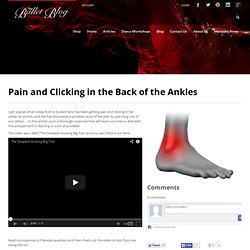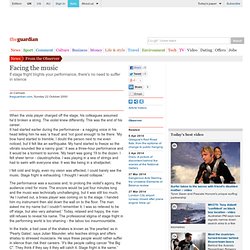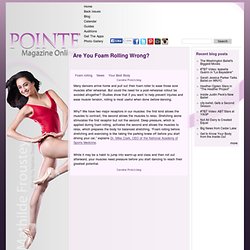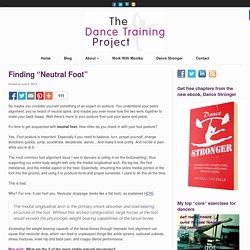

Pain and Clicking in the Back of the Ankles. I got a great email today from a student who has been getting pain and clicking in her ankles en pointe, and she has discovered a possible cause of her pain by watching one of our videos… In this article I post a thorough response that will teach you how to deal with this and get back to dancing as soon as possible!

The video was called “The Dreaded Hooking Big Toe” and you can check it out here… Read my response to Pamelas question, and then check out the video to test if you are doing this to! Hi Lisa, I was looking for some information about pointe and came upon www.theperfectpointebook.com actually by accident. I signed in and I just got the e-mail from you about the hooking of the big toe. My ankles hurts sooo much especially when I pointe but I thought that it’s normal when I dance a lot (6 days per week, 2 hours a day). Waiting for your answer, Pamela Hey Pamela Thanks so much for your email, and for all your lovely comments! First things first… We need to drop your pain levels. All dance, all the time. The Best Treatment for Plantar Fasciitis in Dancers. Health and performers. When the viola player charged off the stage, his colleagues assumed he'd broken a string.

The violist knew differently. This was the end of his career. It had started earlier during the performance - a nagging voice in his head telling him he was 'a fraud' and 'not good enough' to be there. 'My bow hand started to tremble. I doubt the person next to me even noticed, but it felt like an earthquake. Improving the Height of your Demi-Pointe. An essential component of Classical Ballet is having ample strength in the feet to get into a high demi-pointe (or ¾ pointe) position.

Gaining this position is essential for correct technique and balance. Some dancers have excellent pointe range on testing, yet struggle to achieve this height when rising. Lisa Howell offers some exercises and tips to improve range and height of the demi-pointe position. If you have good mobility of your big toe and a good pointe range, but can’t quite show this off in your single leg rises, it is important to train this area in isolation from your regular dance training.
Improving strength and control in this area is a great way to guard against a number of foot and ankle injuries common to dancers. Pointe magazine – Ballet at its Best. Many dancers arrive home and pull out their foam roller to ease those sore muscles after rehearsal.

But could the need for a post-rehearsal rollout be avoided altogether? Studies show that if you want to help prevent injuries and ease muscle tension, rolling is most useful when done before dancing. Why? We have two major receptors in our muscles: the first kind allows the muscles to contract, the second allows the muscles to relax.
How to Release Your Upper Body Tension, Find New Strength, and Become the Next Triple-Threat. I’d like to start off today’s post by sharing an email I received the other day from a reader (who, for the sake of anonymity, I’ll refer to as Shakira) who’s daughter is chaneling J-Lo’s energy, and training to become the world’s next big-time triple-threat superstar.

I am writing on behalf of my 14 year old daughter. 11 Exercises that Help Decrease Knee Pain. If your knees are giving you problems, and you feel like the Tin Man from "The Wizard of Oz" when getting out of bed, rest assure that at least you’re not alone.

In fact, nearly 50 million Americans feel the exact same way. Knees are the most commonly injured joints in the body. Considering that when you simply walk up stairs, the pressure across your knee joints is four times your body weight, it isn't surprising. Simple, everyday wear and tear can end up hurting your mobility.
The Dance Training Project. So maybe you consider yourself something of an expert on posture.

Specialized Strength and Conditioning for Dancers. How To Perform The Perfect Tendu. While something as ‘simple’ as a Tendu gets taught very early on in most ballet schools, and is one of the core movements of all ballet steps, it is one of the things that is often poorly understood.

This article breaks down all of the components that makes up the perfect tendu. Hello Lisa! I have so enjoyed your email updates about dance and anatomy that I am finally reaching out with a question of my own. How To Perform The Perfect Tendu. Core Stability Course for Dancers. Chronic Hip & Back Pain in Hypermobile Dancers. One of the most common occurrences that we see in the clinic is Full Time Dancers with chronic back and hip pain. The curious thing is that many of these students also have recurrent or chronic issues with their digestive system. This interaction is extremely complicated, but I wanted to write an article on the first level of this relationship, and how we can help dancers through it. I hope it makes sense! These students are also usually hyper mobile, which is often desirable in a dancer, however at present if they also lack the deep control of her local stabilisers (especially the small deep back muscle, pelvic floor and deep abdominals, as well as her true turnout muscles) to control this increased movement effectively, they will often have problems.
If the deep muscles are not effectively engaging to control the spine at a segmental level, then the bigger back muscles will grip on, trying to substitute for the deeper ones. Why Exercise Helps You Think Straight. Foot_arches.jpg (962×548)